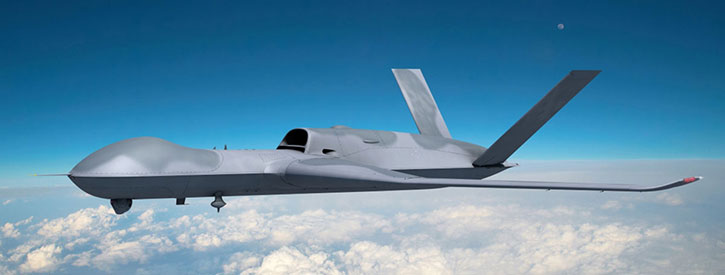Multi-drones provide aerial picture of the situation for joint multi-area operations

General Atomics recently conducted a flight demonstration of two Avenger Unmanned Aircraft Systems (UAS), each equipped with Lockheed Martin’s Legion IRST21 pod, an infrared search and tracking pod designed to detect long-range aerial targets, without using radar.
The information obtained by the pods was processed on board with advanced fusion software that mixed the data from the sensors of the two pods, and the Avengers transmitted it to the ground station in real time, providing an aerial picture of the situation. at the command center. “The Avenger with Legion Pod demonstrated how collaborative autonomous platforms with advanced sensing can deliver persistent and shared knowledge of the air domain. Michael Atwood, senior director of advanced programs at GA-ASI, explained.
“This is the first time that IRST systems on multiple autonomous aircraft have provided fused air threat data to ground users,” added Scott Roberson, director of advanced sensor and global support programs at Lockheed Martin. Lockheed Martin designed the Legion Pod to passively detect and track targets of tactical fighter pilots in environments without radar. This capability provides the data necessary to enable unmanned vehicles to track and engage hostile airborne targets without human intervention.
Fusion technology has already been tested in F-15Cs equipped with Legion Pods and datalinks deployed for Operational Exercise Northern Edge in 2021, where the pods have demonstrated their ability to autonomously detect and track targets. of long-distance interest. The Avenger range flight test series began in December 2020 to demonstrate next-generation air-to-air applications of unmanned aerial vehicles. The integration of the gimbal and the unmanned platform allows the drone to maneuver for optimized target engagement autonomously.
This capability brings drones closer to autonomous systems supporting the Unmanned Team (MUM-T) in joint operations in all fields. Transported on F-15Cs, Legion Pods have already demonstrated passive target spotting for AIM-120 and AIM-9X missile tests.
General Atomics MQ-20 Avengers N901PC & N903PC “SKYBORG01 & 03” arriving at El Mirage Field this afternoon equipped with Lockheed Martin Legion pods. (October 26, 2021). pic.twitter.com/Cqg5jXUVTR
– Airplane spots (@AircraftSpots) October 27, 2021
The sensor’s Open Mission System (OMS) design easily supports the All-Field Joint Operations (JADC2) requirements for alternative data link architectures. WHO enables rapid integration, making the technology transportable between aircraft platforms and reducing the time and complexity of integration on new platforms. The fusion engine’s ability to integrate multiple sensor sources makes it a central node that connects multiple Legion pods on manned and unmanned platforms. Lockheed Martin intends to test the Legion Pod with data link capability between the F-16s and the F-15 to F-16 sensor fusion.


In addition to this company-funded activity, GA-ASI is also involved in an Air Force demonstration program known as “Off-Map Detection Stations” (OBSS). This program foresees the development of an unmanned platform that will operate alongside current or future combatants, provide sensor support and function as a “weapons bay” under the command of the, thus keeping the aircraft piloted in. a quarterback position away from danger. Operating far forward and carrying IRST sensors, these OBSS drones could provide situational imagery and provide passive indication for long-range missiles launched from a distance. This capability will allow 5GEN and 4GEN fighters to engage unobservable (stealth) targets and launch missiles without activating their radars, thus preventing the enemy from any early warning.
General Atomics is one of the two subcontractors to develop such platforms; the other is Kratos Defense. In November 2021, the two companies were awarded a $ 17.8 million contract from the Air Force Research Laboratory (AFRL) to design an OBSS aircraft. By the end of the year, AFRL plans to select one of the models and invest an additional $ 30 million to build and fly the new drone by 2024.



